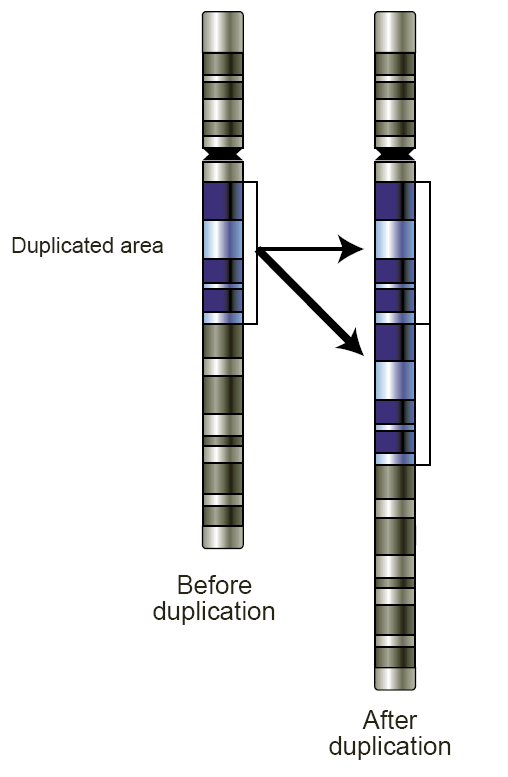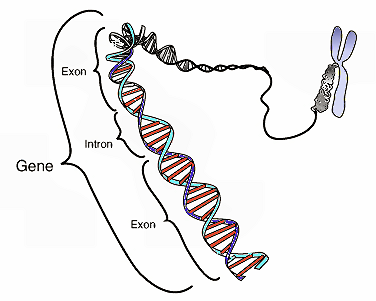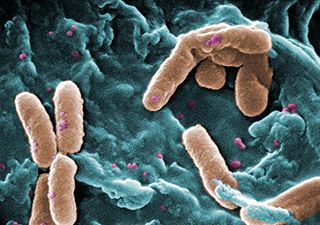
Figure 1.
Duplication of the highlighted gene during replication of the genome.
http://commons.wikimedia.org/wiki/File:Gene-duplication.png
(C)Copyright 2011 by Carl Drews
Updated: December 10, 2011
Contents:
The Mechanism
What Happens to the Duplicate Genes?
Pseudomonas
Conclusion

Figure 1.
Duplication of the highlighted gene during replication of the genome.
http://commons.wikimedia.org/wiki/File:Gene-duplication.png
The biological process of evolution can add new (and useful) genetic information to the genome by gene duplication followed by a point mutation in one of the copies. The modified copy can perform a new biological function while the unchanged copy continues to perform the original function. This process has been observed in the Antarctic eelpout fish, which lives in very cold water. The gene that produces antifreeze protein (AFP) is thought to have evolved from a duplicate copy of the gene that produces sialic acid synthase (SAS) enzyme. AFP secretes an antifreeze protein into the eelpout's bloodstream, allowing the fish to expand its range into colder waters. The overall process is called "escape from adaptive conflict", whereby the copied gene is free to acquire a new function. The references are:

Figure 2.
The Antarctic eelpout fish (Lycodes turneri).
http://commons.wikimedia.org/wiki/File:PolarEelpout-B-Sheiko.jpg
Of course the mutated copy of the duplicate gene still has to produce a viable function in order to be useful. A mutated gene will produce a modified protein. The cell's quality control mechanism will destroy proteins that do not fold properly. However, some modified proteins do make it through the cell's filtering machinery and are expressed in the phenotype. Since altered phenotypes do arise in a population, we know that the cell's quality control mechanism does not eliminate the result of every mutation.
Jianzhi Zhang describes the evolutionary fate of duplicate genes in a scientific review article, "Evolution by gene duplication: an update ", TRENDS in Ecology and Evolution , Vol.18 No.6 June 2003:
http://www.anthro.utah.edu/~rogers/bio5410/Readings/Zhang-TRE-18-292.pdf

Figure 3.
The coding region in a segment of eukaryotic DNA.
http://commons.wikimedia.org/wiki/File:Gene.png

Figure 4.
Scanning electron micrograph (SEM) of a number of Pseudomonas aeruginosa bacteria.
http://commons.wikimedia.org/wiki/File:Pseudomonas.jpg
The Pseudomonas bacteria has evolved the new ability to digest nylon. This process has occurred in the wild and in the laboratory. Nylon was invented and first synthesized in 1935 by Wallace Carothers at DuPont chemical. In the 1970s Japanese scientists noticed that bacterial mats were growing on nylon waste compounds. In 1984 Susumu Ohno found that the nylonase enzyme had arisen by duplicating a gene and then inserting a single extra base into the DNA code (a frame shift). In 1995 Irfan Prijambada reported that researchers at Osaka University had observed the evolution of nylon metabolism in their laboratory cultures of Pseudomonas, after carefully making sure that the original culture had no ability to digest nylon. This new and useful genetic information arose from the standard evolutionary processes of mutation, natural selection, and reproduction. Reference: Only a Theory: Evolution and the Battle for America's Soul, by Dr. Kenneth R. Miller of Brown University, 2008, pp. 79-84.
Evolution is a search algorithm that explores the design space of living organisms. This algorithm is executed by a massively parallel set of processors, each consisting of a single member of the interbreeding population. In computer programming, it is usually a series of loops that execute the search. Since biology has no loops, randomization is used instead to step through the possibilities and test each configuration. Mutation plus natural selection extracts information from the environment by matching these random mutations with fitness and successful reproduction of the organism. Biological evolution is a pretty clever system! Our God is an awesome God.
Carl Drews
December 4, 2011